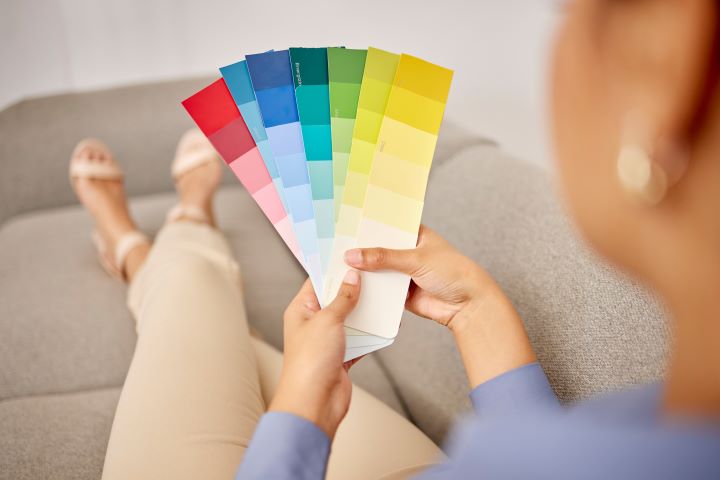Choosing the right paint colour for your room can be a tricky task. There are so many different colours to choose from, and it can be hard to decide which one will work best in your space. Here are a few tips to help you choose the perfect paint colour for your room:

Consider the size of your room
No matter what paint colours you ultimately choose for your home, it is important first to consider the size of the room you are painting. Depending on the amount of light the room receives and other factors, specific colours can make a room feel larger or smaller.
For small rooms, light colours are often the best choice. They help to reflect light and make the space feel more open. On the other hand, dark colours can make a small room feel cramped and intimate. If you want to use a dark colour in a small space, it is often best to limit it to one wall or accent area.
In larger rooms, you have more flexibility when painting colours. For example, dark colours can make a large room feel more cozy and intimate, while light colours can help to brighten and open up the space. To see their effect in your particular room, it is important to experiment with different colours.
No matter what paint colours you choose, it is crucial to consider the size of the room. Doing so can ensure that the selected colours will work well in the space and create the atmosphere you are hoping for.
Think about the amount of natural light in your room
It’s no secret that light plays a massive role in how we see colour. Furthermore, studies have shown that light can change how we perceive colour. So it’s no wonder that when it comes to choosing paint colours, one of the first things you should consider is the amount of natural light in your room.
Natural light can make or break a paint colour. If a room lacks natural light, dark paint colour might make it feel small and cramped. On the other hand, a room with lots of natural light can handle a dark colour much better. It’s all about finding the right balance for your space.
When choosing paint colours, it’s important to consider the amount of natural light in the room. Depending on the light, the colour can look different. So, if you’re unsure about a colour, it’s always a good idea to test it in the room first to see how it looks in the light.
Determine the mood you want to create in your space
When considering paint colours for a space, you must consider the mood you want to create. For example, do you want an area that’s calming and serene? Or are you looking for something more energetic and exciting?
The colours you choose can significantly impact the overall mood of a space. So, if you’re trying to create a certain feeling in your room, it’s important to choose paint colours that will help you achieve that.
Calming and Soothing: If you want to create a calm and relaxing space, stick to cool colours like blues and greens. These colours have a calming effect on the mind and can help to create a sense of peace.
Energetic and Exciting: On the other hand, if you’re looking for a more vibrant and exciting space, go for warmer colours like reds and oranges. These colours are known to stimulate the mind and can help to create a sense of excitement.
As an example, if you want your kitchen to feel cozy and inviting, you might want to choose warm, neutral colours. Or, if you want your room to feel more formal and sophisticated, you might want to choose cooler, darker colours.
Whatever mood you’re trying to create in your space, there’s a colour that can help you achieve it. So, when you’re choosing paint colours, be sure to keep the mood you want to create in mind.
Consider the furnishings in your room
When considering paint colours for your room, it’s important to consider the colours and materials of your furniture. Depending on the style of your room, you may want to create a cohesive look by choosing paint colours that complement your furniture, or you may want to use paint to create a contrast against your furnishings. Either way, the colours you choose can significantly impact the overall look and feel of your space.
If you have a lot of wood furniture, you may want to consider choosing a paint colour that will help to accentuate the wood. For example, if your furniture is a dark cherry wood, you could choose a paint colour with red undertones to bring out the richness of the wood. Or, if your furniture is a light maple, you might want to consider a warm white or cream paint colour to help brighten up the space.
On the other hand, if you have upholstered furniture in a light fabric, you may want to choose a paint colour that will help balance the fabric’s lightness. For example, if you have a white sofa, you might want to consider a grey or taupe paint colour to help ground the space. Or, if your furniture is upholstered in a brightly coloured fabric, you may want to use a paint colour a few shades lighter or darker than the fabric to help create a sense of balance.
In general, it’s best to avoid using paint colours that are too similar to the colours of your furniture. Instead, try to choose paint colours that are in the same family as the colours of your furniture but that are different enough to create some contrast.

Test out the paint colour in your space
When choosing paint colours, it’s important to test the paint colour in your space before making a final decision. There are a few reasons why this is important.
First, paint colours can look different in different lighting conditions. So, if you paint a room and then realise the colour looks different than you anticipated, it can be frustrating. By testing out the paint colour in your space, you can better understand how it will look in the room’s natural light.
Second, paint colours can also look different on different walls. For example, one wall might be a different colour than the others because of how the light hits it or the wall’s texture. By testing out the paint colour on all the walls in the room, you can get a better sense of how it will look once the entire room is painted.
Finally, paint colours can also look different in person than they do online or in a paint chip. This is because paint chips are small and can be misleading. And while online images can give you an idea of paint colour, they can also be deceiving. The best way to know for sure if a paint colour is the right one for you is to see it in person.
Testing out a paint colour in your space before making a final decision is the best way to ensure you’re happy with the results.
Conclusion
When you’ve finally decided on the perfect paint colour, it’s important to choose the right finish.
High-gloss paint is great for areas with a lot of use, such as kitchens and bathrooms because it’s easy to wipe down.
Low-sheen or matte finishes are better for spaces that don’t need to be as clean, such as living rooms and bedrooms.
Once you’ve chosen the right paint colour and finish, it’s time to start painting! Be sure to prep the room first by removing all furniture and covering the floors. Then, follow the directions from your chosen paint brand on how to prep your surfaces for the best results.











